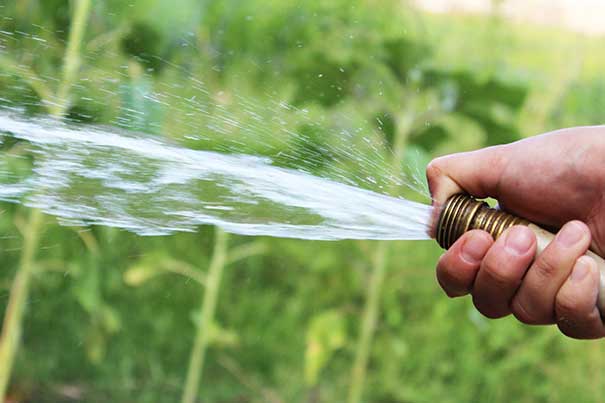
One of the most common reasons plants struggle or die is improper watering—either too much or too little. In Virginia, our heavy clay soil presents additional challenges, making proper drainage essential to prevent moisture-related issues. By following these watering tips, you can help your plants thrive.
How To Water Plants Properly
For most plants, a hose with a nozzle is the best option. Set it to a moderate flow of approximately four gallons per minute—a good test is filling a one-gallon container in 13-17 seconds. Place the hose directly at the base of each plant, allowing water to penetrate about two feet into the soil where roots need it most.
For ground covers, a sprinkler or spray nozzle works well, but these are not recommended for larger plants and trees.
How Much Water Do Your Plants Need?
Using a hose without a nozzle, follow these general guidelines:
| Plant Size | Minutes of Watering |
|---|---|
| 1 – 2′ | 2 min |
| 2 – 3′ | 3 min |
| 3 – 5′ | 5 min |
| 6 – 8′ | 6 min |
| 1.5 – 2″ caliper trees | 8 min |
| 2 – 2.5″ caliper trees | 10 min |
| 2.5 – 3″ caliper trees | 12 min |
| 3″ or larger caliper trees | 15 min |
If your soil has poor drainage, water in 2-3 minute intervals, allowing time for absorption. A time-saving trick is to start watering large plants first, then move to smaller ones before returning for a second round.
When To Water Your Plants
The more porous the soil, the more frequently you’ll need to water. In late spring and summer, plants require more water due to rising temperatures and drier conditions.
- Shaded plants need less water than those in full sun.
- Foundation plants on the south and west sides of your home dry out faster due to prolonged sun exposure.
- Newly planted trees, shrubs, and flowers should be watered heavily when first planted and every other day for the first three weeks. Afterward, water when the soil feels dry.
Additional Watering Tips for Lawns, Trees, and Containers
Water, water everywhere, but not always where you want it when you want it there. The legendary kingdom of Camelot had a great rule: “The rain may never fall till after sundown. By eight, the morning fog must disappear.” Unfortunately in our parts, we have to deal with what we get. In most cases, established plantings do just fine with what nature furnishes, but it’s a different story when it comes to lawns and newly planted trees and shrubs. Summer often brings hot, dry spells when supplemental watering is a must. Here are a few things to keep in mind.
For Your Lawn
- If you’ve just seeded your lawn, keep the soil consistently moist—drying out at this stage can kill new grass.
- Water deeply and thoroughly rather than in short, frequent bursts. This encourages deep root growth, making the grass more drought-resistant.
- Aim for at least one inch of water per week.
- Water early in the morning to minimize evaporation and give your lawn moisture for the day.
For Trees, Shrubs, and Flowers
- Mulching helps retain moisture, reduces evaporation, and prevents weeds from competing for water.
- Trees and shrubs need slow, deep watering. Set your hose to a low trickle and water at the base of the plant.
- Automatic irrigation systems don’t always provide enough water for deep-rooted plants—be sure to supplement as needed.
- A soaker hose is ideal for flower beds, as it delivers water directly to the roots with minimal waste.
For Containers and Hanging Baskets
- Container plants dry out faster since their roots can’t spread out in search of water. Check them daily, especially in hot weather.
- Ensure pots have drainage holes to prevent root rot.
- Use water-retaining products like Soil Moist, which absorbs and slowly releases water into the soil.
Stock Up on Gardening Supplies at Your Local Meadows Farms
Need a new hose, plant food, or expert gardening advice? Meadows Farms has everything you need to keep your plants happy and hydrated. Find your nearest location to get started today!

